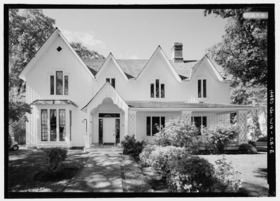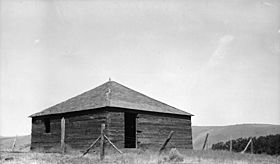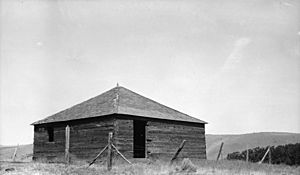Fort Simcoe facts for kids
Quick facts for kids Fort Simcoe Historical State Park |
|
|---|---|

Commandant's House
|
|
| Lua error in Module:Location_map at line 420: attempt to index field 'wikibase' (a nil value). | |
| Location | Yakima County, Washington, United States |
| Area | 200 acres (81 ha) |
| Elevation | 1,401 ft (427 m) |
| Established | 1856-1859 fort; 1953 park |
| Administered by | Washington State Parks and Recreation Commission |
|
Fort Simcoe State Park
|
|

Fort Simcoe blockhouse, ca. 1930s (HABS archives)
|
|
| Location | Yakima County, SW of Yakima on SR-220 |
| Nearest city | Yakima, Washington |
| Built | 1856 |
| Architect | Robert Seldon Garnett; Louis Scholl |
| Architectural style | Gothic Revival |
| NRHP reference No. | 74001994 |
| Added to NRHP | June 27, 1974 |
Fort Simcoe was an old United States Army fort built in what is now south-central Washington. It was created to house soldiers who watched over local Native American tribes. Today, the fort and its remaining buildings are part of Fort Simcoe Historical State Park. You can find it about 8 miles (13 km) west of White Swan, Washington, nestled in the foothills of the Cascade Mountains.
Contents
Fort Simcoe: A Look Back in Time
Fort Simcoe has a long and important history. It tells a story about the past, including how Native American tribes and the U.S. Army interacted. The park helps us understand what life was like in the mid-1800s.
Early School for Native American Children
Before the fort was built, the area was used as a school. Native American children from different tribes across Washington were sent there. They were taught to speak English and follow American customs. This meant they often had to stop practicing their own traditions. Sometimes, children who did not follow the rules were put in a small jail.
Building the Fort and Its Purpose
The fort was built between 1856 and 1859. It was located in an old oak grove with natural springs. A future Civil War general named Robert S. Garnett oversaw its construction. The fort was used by the army for only three years. Later, in 1953, it became a state park.
The fort was placed along a route that the Yakama people used. They traveled between the Yakima Valley and their traditional fishing spots on the Columbia River. This location allowed soldiers to keep an eye on the tribe and anyone visiting them.
Impact on Native American Tribes
The U.S. government brought 14 different tribes together at Fort Simcoe. They were encouraged to adopt American culture. This meant learning about famous Americans and being given Christian or American names. This process caused many tribes to lose some of their original traditions and ways of life.
In 1922, the government decided to move the Indian agency from Fort Simcoe to Toppenish. This move brought back difficult memories for the tribes, as it reminded them of past relocations.
Designing and Connecting the Fort
The fort was designed and built by an architect named Louis Scholl. It had blockhouses at each corner, similar to Fort Dalles. However, it did not have a tall fence (called a stockade) around it. Instead, the barracks (soldiers' living quarters) formed the fort's outer shape.
Creating roads to Fort Simcoe was a big challenge. James Harvey Wilbur and Captain Frederick Dent worked to build a road system. Their goal was to connect California with the Washington Territory.
Exploring Fort Simcoe Historical State Park
Fort Simcoe Historical State Park covers 200 acres (0.81 km2). It is a day-use park located on the Yakama Indian Reservation. The park helps visitors learn about army life in the mid-1800s. It also shares stories about the lives of local Native Americans.
What You Can See at the Park
Five of the original buildings from the fort are still standing today. These include the commander's house, three captain's houses, and a blockhouse. Other buildings have been rebuilt to look like the originals. The houses are filled with furniture from that time period. In 1974, the park was added to the National Register of Historic Places.
Visiting the Park and Museum
The park's interpretive center is open from April through September. You can visit Wednesday through Sunday. During these times, you can also explore the original commander's house and two officer's buildings. These buildings are decorated with period furnishings. The original blockhouse and other recreated fort buildings are not open for visitors to go inside.
The park often hosts special events. These include re-enactments and "living history" days. During these events, people dress up and act out what life was like at the fort.


